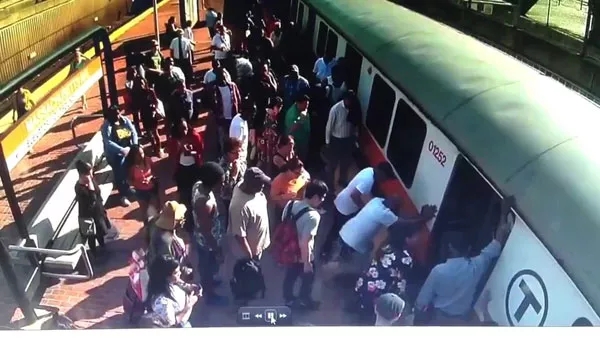近日,美國(guó)馬薩諸塞州一名女子腿被卡在地鐵列車與站臺(tái)之間的縫隙中,她的第一反應(yīng)竟是哭著懇求周圍路人不要叫救護(hù)車,因?yàn)榻芯茸o(hù)車需要3000美元,她付不起。此事在社交媒體上引發(fā)了有關(guān)美國(guó)醫(yī)療保障體系的熱議。
我們來(lái)看看外媒的報(bào)道:

The 45-year-old was walking off Boston's Orange Line train at Massachusetts Avenue around 5.30 pm on Friday when she lost her footing and plunged down the gap, giving her a deep cut that went right down to the bone.
上周五下午5點(diǎn)半左右,這名45歲的女子正離開(kāi)馬賽諸塞大道的波士頓捷運(yùn)橘線列車,突然沒(méi)站穩(wěn),腿被卡在列車與站臺(tái)縫隙中。她的腿上裂了一個(gè)大口子,傷口一直深到骨頭。
Her fellow passengers helped push the train to the side and free her, but even as she thanked them, shaking and weeping from the pain, she begged them not to call an ambulance because it cost too much.
其他乘客一起幫忙挪開(kāi)了列車,將她救出,但她在向大家表示感謝的時(shí)候,還懇求大家不要叫救護(hù)車,因?yàn)橘M(fèi)用太高,而當(dāng)時(shí)她痛到渾身顫抖,泣不成聲。
'Do you know how much an ambulance costs?' she said. 'It's $3,000,' she said. 'I can't afford that.'
她說(shuō):“你知道叫救護(hù)車要花多少錢嗎?3000美元!我可掏不起。”
The woman's heartbreaking pleas have reignited the debate around healthcare in the US, with many branding it 'barbaric' that someone should be forced to choose between life and debt.
這名女子令人心碎的懇求激起了美國(guó)民眾對(duì)醫(yī)療狀況的熱議。很多人說(shuō)美國(guó)的醫(yī)療體系“野蠻原始”,竟逼迫人們?cè)谝€是要錢之間作出選擇。
'It is absolutely disgraceful that someone has to worry about the cost of an ambulance in a situation like that. My thoughts are with her,' said Twitter user Yalina.
推特用戶雅琳娜說(shuō):“傷成那樣的情況下還得擔(dān)心救護(hù)車的費(fèi)用,這絕對(duì)是醫(yī)療體系的恥辱。我很同情她。”
Another wrote: 'We need universal healthcare, an accident shouldn't force you to choose between crushing debt or permanent injury/death.'
還有人寫道:“我們需要全面覆蓋的醫(yī)療服務(wù),不能因?yàn)橐黄鹨馔饩妥屓诉x擇是負(fù)債還是給身體造成永久性損傷,甚至死亡。”
'It's barbaric, outdated, and just unrealistic,' another tweet read.
另一位用戶說(shuō):“美國(guó)的醫(yī)療體系野蠻原始、過(guò)時(shí),而且不切實(shí)際。”
Many Americans said they are angry with the current state of healthcare, which they say is confusing, unfair and overly expensive.
很多美國(guó)人表示他們對(duì)目前的醫(yī)療狀況很憤怒,目前美國(guó)的醫(yī)療讓人困惑,不公平,而且太貴。
Americans spend more money on healthcare than any other population, and healthcare spending rocketed $900 billion between 1996 and 2013.
美國(guó)人的醫(yī)療費(fèi)用比其他國(guó)家都要高。從1996年到2013年,美國(guó)人的醫(yī)療花費(fèi)暴增了9000億美元(約合6萬(wàn)億元人民幣)。
By 2013, total healthcare spending hit $2.1 trillion, according to the study published in the Journal of the American Medical Association. The researchers say that figure has now likely soared to more than $3.2 trillion, which equates to 18 percent of the country's economy.
根據(jù)《美國(guó)醫(yī)學(xué)協(xié)會(huì)期刊》公布的研究數(shù)據(jù),截至2013年,美國(guó)的醫(yī)療花費(fèi)總額達(dá)到2.1萬(wàn)億美元。研究人員說(shuō),這一數(shù)字目前可能已經(jīng)飆升至超過(guò)3.2萬(wàn)億美元,相當(dāng)于美國(guó)經(jīng)濟(jì)總量的18%。
But while spending increased, America's life expectancy has remained sluggish - with an average of 79 years old, compared to the global average of 83 years old.
盡管支出上升,美國(guó)人的預(yù)期壽命卻止步不前,平均為79歲,而世界平均預(yù)期壽命已經(jīng)達(dá)到83歲。
The US is the only country in which wealth has been linked to life expectancy with a study finding that the richest one percent were found to live an average of 15 years longer than the poorest one percent.
美國(guó)是唯一一個(gè)財(cái)富與預(yù)期壽命有關(guān)的國(guó)家。一項(xiàng)研究發(fā)現(xiàn),美國(guó)最富有的1%人群平均壽命比最貧窮的1%人多出15歲。
The tweet that started the debate came from Boston Globe reporter Maria Cramer who was on the platform when the woman got her leg trapped.
這名女性腿被卡住時(shí),《波士頓郵報(bào)》記者瑪利亞·克萊默剛好在站臺(tái)上。她目擊了這起事件并發(fā)表了推特,從而引發(fā)了這場(chǎng)爭(zhēng)論。

她寫道:“橘線上的可怕一幕。一名女士的腿被卡在列車與站臺(tái)的縫隙之間,場(chǎng)面嚇人還流了好多血,皮肉都破了。她特別痛苦,一直在哭。她都這么痛苦了,可是還在懇求人們不要叫救護(hù)車。她哭著說(shuō),‘救護(hù)車要3000美元,我付不起。’”
The tweet has been shared and liked tens of thousands of times.
這條推特已被分享和點(diǎn)贊數(shù)萬(wàn)次。
Meanwhile, the victim who has not been named, was eventually taken to the Boston Medical Center, where her thigh was found to have a 'serious laceration, exposing the bone' that would need surgery.
最終,這位不具名的傷者被送往波士頓醫(yī)療中心,她的大腿“嚴(yán)重撕裂,露出骨頭”,需要手術(shù)治療。
Boston EMS chief Jim Hooley said ambulance callouts generally costed up to $1,900 for people with pressing needs, like resuscitation.
波士頓緊急救護(hù)局局長(zhǎng)吉姆·胡利表示,在波士頓,急需救護(hù)(比如需要心肺復(fù)蘇)的人叫救護(hù)車一般花費(fèi)最多1900美元。
resuscitation [r?,s?s?'te???n]:復(fù)蘇
'We just worry about taking care of people,' Hooley said. 'We don't want to cause them more stress.'
他說(shuō),“我們只擔(dān)心照顧傷者。我們不想給他們?cè)斐蛇^(guò)多的壓力。”
'We just want to reassure them that nothing bad is going to happen to them because of their inability to pay.'
“我們只希望讓他們放心,不會(huì)因付不起錢而導(dǎo)致不好的事發(fā)生。”
在美國(guó),救護(hù)車出勤的醫(yī)療費(fèi)用差異很大,病情不明,很難說(shuō)費(fèi)用多少。
2012年的聯(lián)邦調(diào)查發(fā)現(xiàn),每次乘坐救護(hù)車的成本平均在224美元(約1485元人民幣)至2204美元(約14610人民幣)之間。
由于對(duì)沒(méi)有醫(yī)保的人來(lái)說(shuō),美國(guó)醫(yī)療費(fèi)用過(guò)于昂貴,我國(guó)赴外留學(xué)生中,一直流傳著“暈倒別喊救護(hù)車、病倒不要去醫(yī)院”的話。
就連美國(guó)本國(guó)人,也常常不舍得叫救護(hù)車。
媒體報(bào)道了女子拒絕叫救護(hù)車的新聞后,美國(guó)網(wǎng)友心有戚戚,紛紛表示明白女子的選擇。
@Quidditch_Queen:
大城市的人寧可坐Uber或者Lyft去急救中心,叫Uber頂多45美元,叫救護(hù)車至少要1500美元(如果急救人員覺(jué)得沒(méi)必要鳴笛,絕大部分時(shí)候路上用的時(shí)間是一樣的)。我寧愿把這錢給我老鐵戴夫,他就住我家2.8英里遠(yuǎn)的地方,比救護(hù)車到得還快。
@Stupidstray:
我跟我室友約好了,除非我們?cè)诖箫j血,要把最后一滴血流干了,否則就開(kāi)車或者打個(gè)Uber送對(duì)方去醫(yī)院,絕對(duì)不能叫救護(hù)車。救護(hù)車也許能救我的命,但叫救護(hù)車花的錢,會(huì)讓我寧愿死了干凈。
@throwmefarfaraway123:
太難過(guò)了,我們(美國(guó)人)的稅都交哪兒去了?
我住在香港,之前在練習(xí)打橄欖球的時(shí)候,肋骨骨折了,疼得幾乎動(dòng)不得,需要救治。救護(hù)車把我送到了最近的公立醫(yī)院,問(wèn)診、X光、2個(gè)月的藥=180港幣(23.07美元)。
@clarkrd:
美國(guó)人的稅去哪兒了?買炸彈了呀!那些戰(zhàn)斧導(dǎo)彈可不便宜,無(wú)人轟炸機(jī)也不便宜。
我們的道路和橋梁正在塌陷,我們的人民不敢生病,我們的學(xué)校跟屎一樣。 但我們有最好的炸彈、最美麗的炸彈。
(來(lái)源:中國(guó)日?qǐng)?bào)雙語(yǔ)新聞編輯部)
